THE FAMILY SEARCH METHOD
By Mark Nelson
 March 8, 2024
March 8, 2024
I decided to make a step-by-step guide explaining my search method. People keep telling me I should write a book about this stuff. Well, here it is. It's not a book, but this will be my largest blog post yet. This could be useful for anyone who wants to do their own DNA family search. My previous tutorials did not say much about shared DNA matching. This one is more involved and will give you a step-by-step look at shared DNA, family trees and relationships.
Even though I figured this out all on my own, I’m sure there are other people using a similar approach. I can’t say I, or anyone else, "invented" this. It’s really just basic genetic genealogy. My goal here is to come up with a useful way to explain it so anyone can do a search themselves. There are videos and articles about this subject that will leave you saying, "What the heck are they talking about?" I’ve seen techniques online to try to help you, and I didn't like any of them. There’s a popular one that involves making color coded spreadsheets to sort your ancestors. I’m not sure why that’s necessary, but if that helps you, great. Find your answer any way you can. I’ve never used anything like that though. I think the best way to get people to understand this subject is to involve them in the process of solving real-life cases. As I explain, I’ll ask questions and keep the answers hidden until you click on them. This will make things a bit more interactive and give you time to think before you continue reading.
Before we begin, I want to make one thing clear... THERE IS NO ONE SINGLE METHOD OR MAGIC FORMULA FOR FINDING YOUR BIRTH FAMILY. There are situations that are so easy, no knowledge of genealogy or DNA is required at all. There’s other situations that require a whole lot of research that DNA just isn’t going to help with. It’s really all about knowledge, logic, research and sometimes luck. My personal opinion is, if you’re not planning on becoming a genealogist, I recommend having someone help you with your search. It could save you a whole lot of time and aggravation. I do understand though. People get a lot of satisfaction out of figuring out their own family mysteries. I totally get it.
The example I'll be using involves a fairly easy case that requires some DNA knowledge and some family relationship knowledge. This is similar to some of the easier cases I deal with, but I'll throw some curve balls at you to make it a little tricky. Before we get into the search, let's take a look at some elements of my method, then we'll see how this all comes together.
Understand family relationships

Know the meaning of: Second cousin, removed cousin, half cousin, etc. You can learn about this subject by reading various pages in my blog. I’ll put the links below. If anyone says you can work with DNA and family trees and not need an understanding of family relationships, don’t listen to that person. It’s important. I once worked with a woman who kept insisting that her cousin’s daughter was her second cousin, and her cousin’s granddaughter was her third cousin. NO! That’s not correct and your DNA results won’t make any sense if you believe that. Trust me, take some time to learn about relationships.
Understand centimorgan values

Know how many centimorgans to expect from a relationship with a first cousin, second cousin, etc. You don’t have to memorize them. There are charts available to help you. I even made a centimorgan calculator for you to use on one of my blog pages. You should also understand that DNA levels double or half with each generation difference. (Not always true. I’m simplifying here). You’ll see what I mean in my example. I also like to put matches in two categories. I refer to them as, perfect matches and in-between matches. You will likely see some confusing data in your searches. Matches may have an "In-between" number. By that I mean, something like 600cM. It’s pretty low for a first cousin, but pretty high for a half first cousin. A match of 900cM is perfect for a first cousin. When I have matches with numbers that give me high confidence of the relationship, I start working with those first.
Make assumptions

This is something I do that some people may not, and I do it a lot. Before I get deep into the research, I will sometimes look at a match and assume the person is related in a specific way. Then I do the research later to try to prove or disprove my assumption. This allows me to create a starting point. You need a place to start looking. Making assumptions is often a good way to do that. If you assume correctly, it can really speed up the search process. Even if your assumption ends up being wrong, that’s ok. An incorrect assumption is not a failure because now you know not go in that direction. You'll see what I mean when we start our search.
Think logically

My ability to think logically is the biggest reason for my high success rate when finding families. I often credit my success with genealogy to my understanding of computer programming. I’ve been programming since age twelve (over forty years). Don’t worry, you won’t have to do any programming to solve your family mysteries. There is a similarity though. Programming is all about logic and numbers, and I use a very logical approach when finding birth parents or other family members. I’ve been told I’ve solved things that expensive genealogists were not able to solve, so I must be doing something right.
Know how to confirm things

You might have some really good matches and everything looks correct based on those matches. Go beyond that if possible. Really try to complete the puzzle. Find documents, other DNA matches, family members who will talk to you or any other data you can find. I'll discuss how to use distant matches as a way of confirming relationships. Make sure you can back up what you discover with some real facts and make sure the DNA numbers make sense. You wouldn’t want to falsely accuse someone of being a birth parent because you made an error.
Let's begin our search
We'll be looking at a typical search for someone's birth parents. This is based on a real case I worked on last year, but I'll use fictitious names. I’ll be using the Ancestry website for this example. Ancestry does a lot of the work for you if you know how to use it. It now separates your match list for you by parent. This feature wasn’t available a few years ago, so this is a major advancement. It won’t tell you which set of DNA matches are from your mother’s or father’s side. It will just label them Parent 1 and Parent 2. That’s ok though. This is still very helpful. I would start by looking at both match lists. See which list has higher cM numbers. Let’s say Parent 1’s list has some high matches. We'll see if we can find parent 1. Pretend this is your match list and you were born in Chicago in 1961. A real match list will have many more matches, but for this example, I've included only the ones we'll need.
Note: Since we're using fictitious names, you won't be doing any research with documents. This tutorial is more about the DNA and understanding relationships. We'll pretend we did the research and I'll provide you with the info we found. Perhaps I'll do another post specifically about the document research part if it.
Match list for parent 1
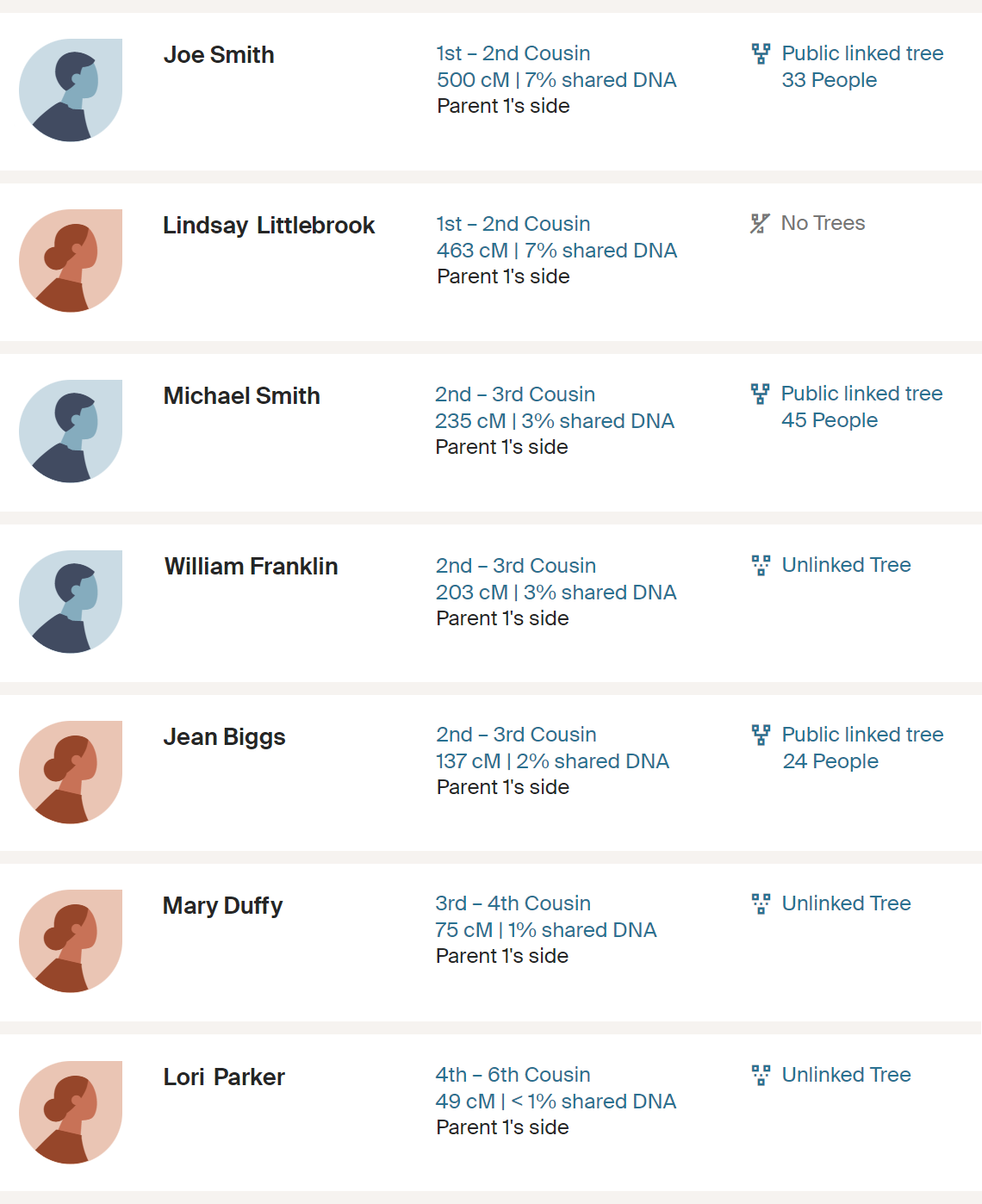
Our goal here is to figure out how these people are related to you. We can determine this by: 1) The amount of centimorgans shown. 2) The generation the match is in compared to you. 3) By viewing family trees and other data. Those three things are very important. We’re going to start by assuming the relationship. Your top match is a guy named Joe Smith. On the ancestry site, you would click on Joe, then click "Shared Matches". The shared match feature is probably the most important feature on the whole site. It will show you only people related to both you AND Joe (shown below).
Shared Matches with Joe Smith
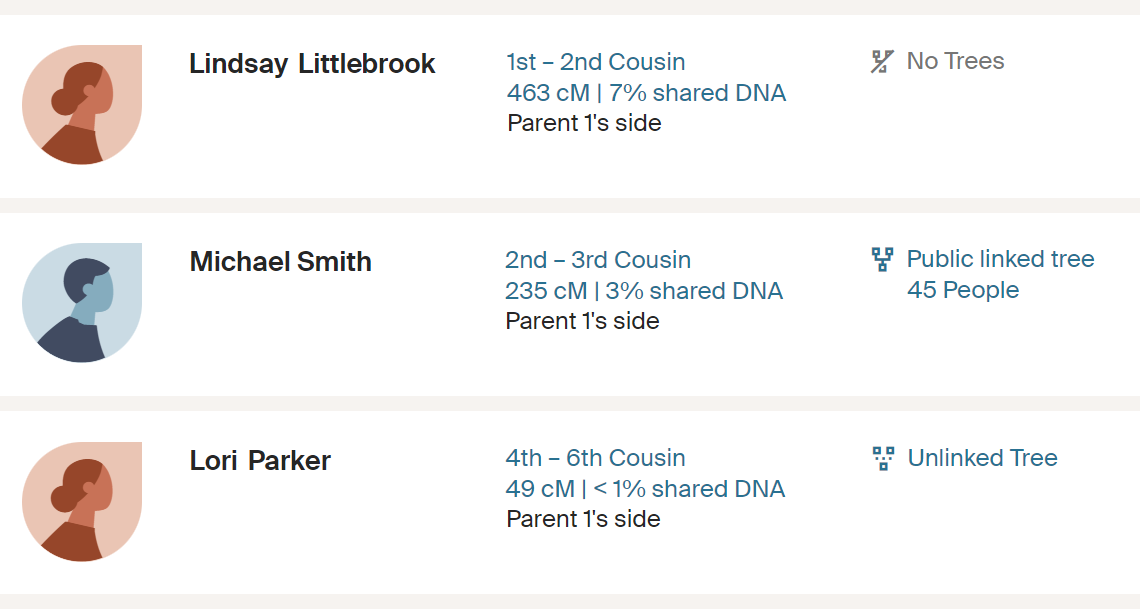
Joe Smith's Tree
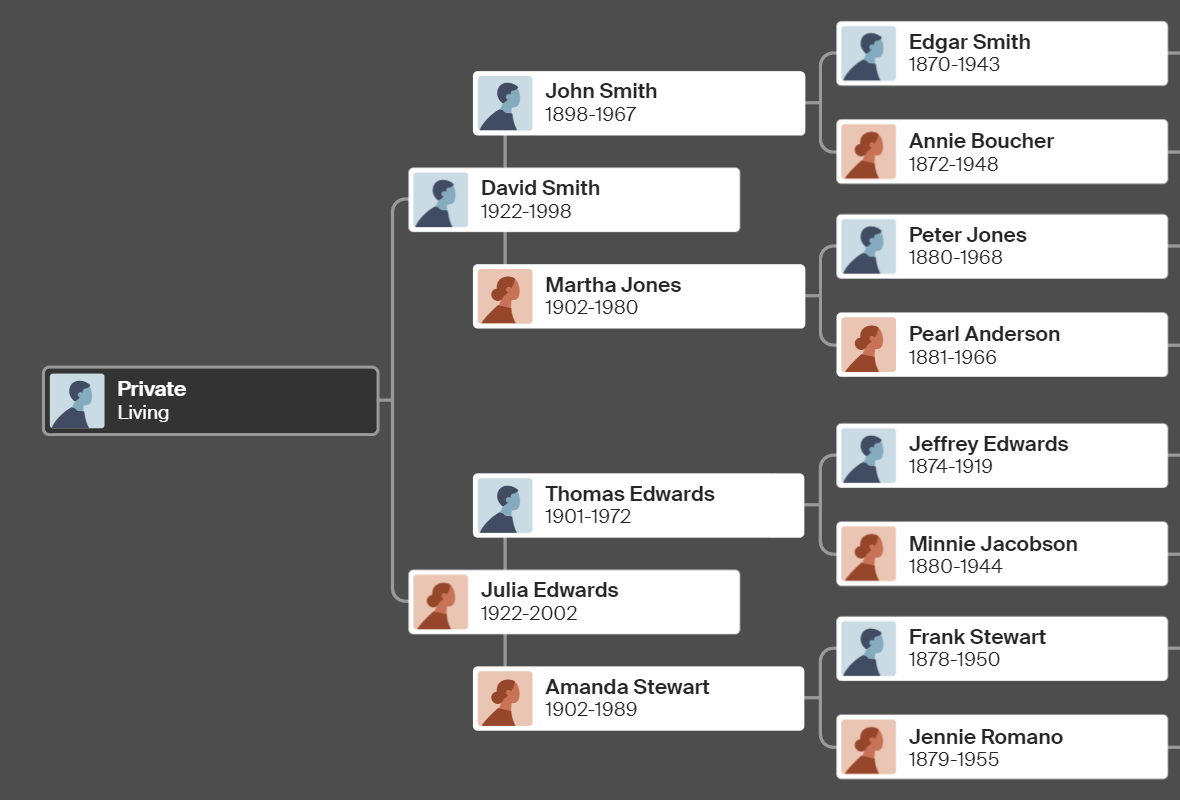
You and Joe have a DNA match of 500cM and you were born in 1961. Joe’s age can’t be seen in his tree (because living people are usually shown as private). In his tree, you can see his parents ages. They were born around 1920 in Chicago. Your parents were likely born around 1940. That’s a pretty good guess anyway. Let’s assume that Joe is quite old and one generation older than you. Makes sense, right? Be aware that age does not always determine generation. It’s even possible for someone older than you to be in a younger generation. It all depends on when people were born in each generation. It can be really tricky. See my blog post about generations for more on this. Again, we are assuming and simplifying this so we have a place to start.
Next, we need to assume that each generation causes the DNA level to double, or half. This is not always the case, but again, we’re simplifying. So, if your match to Joe is 500cM and you are a generation younger than him, then your parent will be in the same generation as him and match him at about 1000cM. Understand the math there? What if your child did a DNA test? What would his match be to Joe?
-
ANSWER
It would be half of your 500cM match. 250cM. Your child is two generations younger than Joe. Make sure you understand that math before continuing. Also be aware that the real numbers are almost never exactly half or double. Sometimes they can even be totally different. I’m explaining this with numbers that are easy to understand. Ideally, this is what you’d want to see. When figuring out relationships, I often like to use this technique. I like to compare two people in the same generation, rather than people in different generations. Since Joe is a generation older than you (I assume). I’d rather look at things from the point of view of your parent who would be in the same generation as Joe. If you have an understanding of centimorgans, then you know that a match of 1000cM to someone in the same generation is usually a first cousin match. It’s one of those numbers I refer to as a “perfect match.” We can now assume your parent and Joe are first cousins.
Do you see what we’ve done? We've just combined all the parts of my method: Understanding relationships, understanding centimorgans, making assumptions and using logic. We still need to prove it though. This is where an understanding of family relationships really comes into play. If your parent and Joe are first cousins, then who would their common ancestors be?
-
ANSWER
First cousins have two grandparents in common. We’re not sure which two yet, but we know it will be two grandparents. Joe’s tree shows all four of his grandparents, so, can we prove you are related to two of them? Look at the four surnames of Joe’s grandparents and make note of them. Joe’s four grandparents are: John Smith, Martha Jones, Thomas Edwards, and Amanda Stewart.
Next I would go down list of people related to you and Joe and look at any trees that are made. I’d make note of any trees containing the same surnames of Joe’s grandparents. As you go down your list, we see Lindsay Littlebrook with a good match. She has no tree though. We’ll skip her for now. Then you come to a guy named Michael. He has John Smith and Martha Jones in his tree also, and they are his great-grandparents. (See tree image below). His DNA match to you is 235cM. We’re already starting to see numbers that make sense. Let’s figure out the relationships. If Joe is your parent’s first cousin, what is your relationships to Joe? What is your relationship to Michael?
-
ANSWER
Joe is your first cousin once removed. The centimorgan number is perfect for that relationship. If that's correct, it would also mean that John and Martha are your great grandparents. You and Michael would be second cousins. Your DNA match of 235cM is perfect for second cousins. Second cousins have two great-grandparents in common.
Michael Smith's Tree
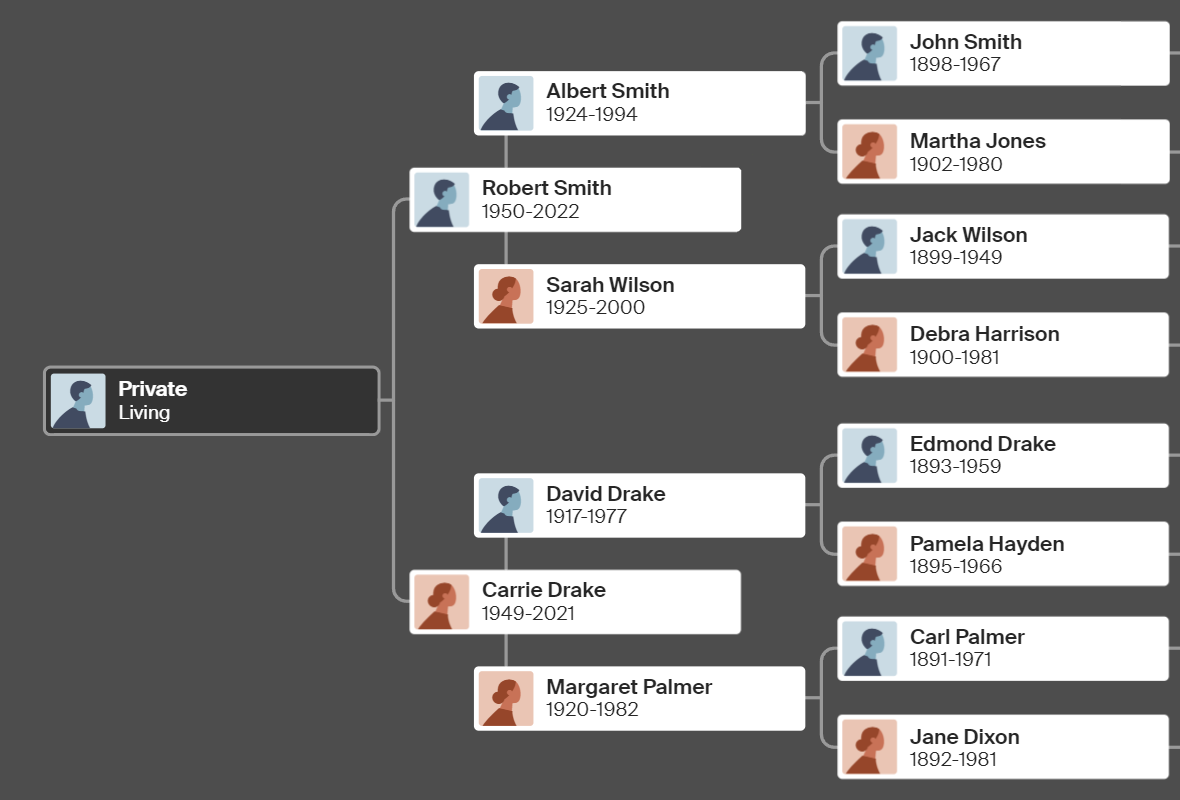
Keep in mind, nothing is confirmed yet, but let’s assume we’re correct so far. Michael’s grandparent is Albert Smith. If Michael is really related in the way we suspect, then your grandparent is going to be a sibling of his grandparent. Your grandparent is also going to be a sibling of Joe’s PARENT. So, your grandparent will be a sibling of Albert Smith and David Smith. Again, there’s a simple example of logic. This is important to understand. Take a moment to think about it if you're unclear.
Now it’s time to do some research. Using census records, the Ancestry search features, and maybe obituaries, you can likely find out who other siblings of Albert and David are. Let’s say you discovered they only had one other sibling, a sister named Jane (1920-2001). If that’s correct, what is your relationship to Jane?
-
ANSWER
Guess what! You just found your grandmother. If everything we found so far is correct, Jane Smith would have to be your grandmother since she is the only other Smith sibling in that family. Make sure you understand what we did here. We're choosing Jane through process of elimination. The two other Smith siblings are David and Albert. If David was your grandfather, Joe's match to you would be higher. If Albert was your grandfather, Michael's match would be higher. Their cM numbers are perfect for the relationships we mentioned. So Jane is all that's left.
Don’t get too excited yet though, there’s more research to do. Next, let’s hope Jane was married only once and didn’t have too many children and didn’t have children with anyone except her husband. That would make things really easy. Using Ancestry’s search features, I would then enter any info I can about Jane and her family, like age, where they were from, etc. To make things easy, let’s say we found out Jane was married to a guy named George Franklin (1918-1998). What’s the next step? Let’s find out if you’re related to George Franklin. Since he was married to your grandmother, it's very possible he was your grandfather.
Remember, you’re currently looking at a list of people related to you and Joe only. Look at Joe’s tree. He’s not going to be a descendent of George Franklin, right? You’re only related to Joe on the Smith side of the family. We now need to go back to our full list for Parent 1. Hopefully we can find someone on your list who is not related to Joe and is related to a Franklin. On our full list for parent 1, we see a guy named William Franklin. Same last name, so maybe he’s related to George. That’s a pretty common name though, so we need to be sure. Let's look at shared matches to William, and William's tree.
Shared Matches with William Franklin
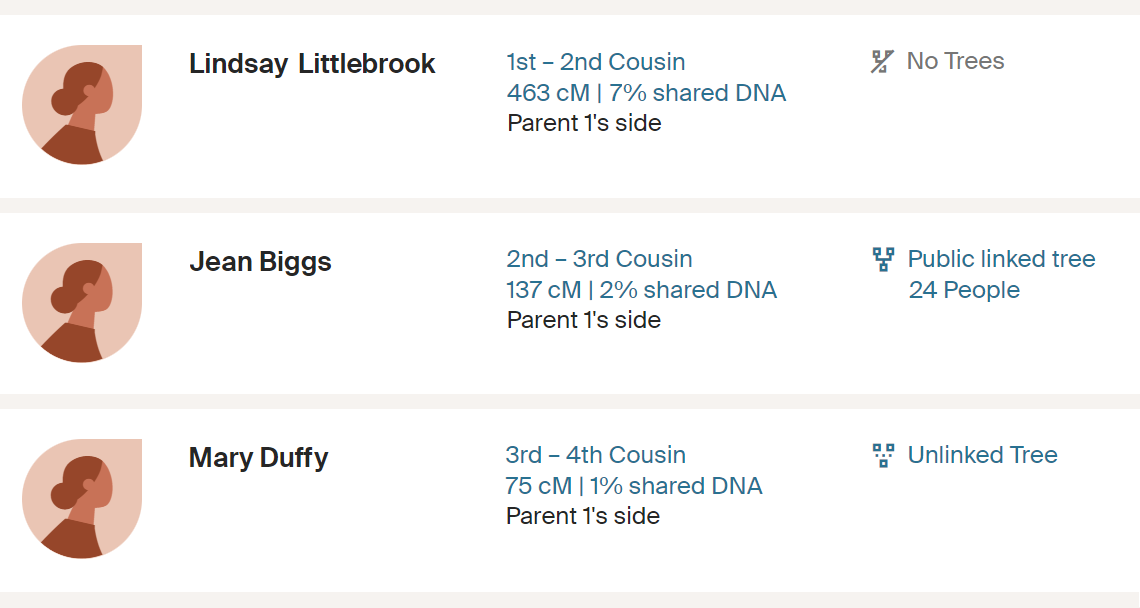
William Franklin's Tree
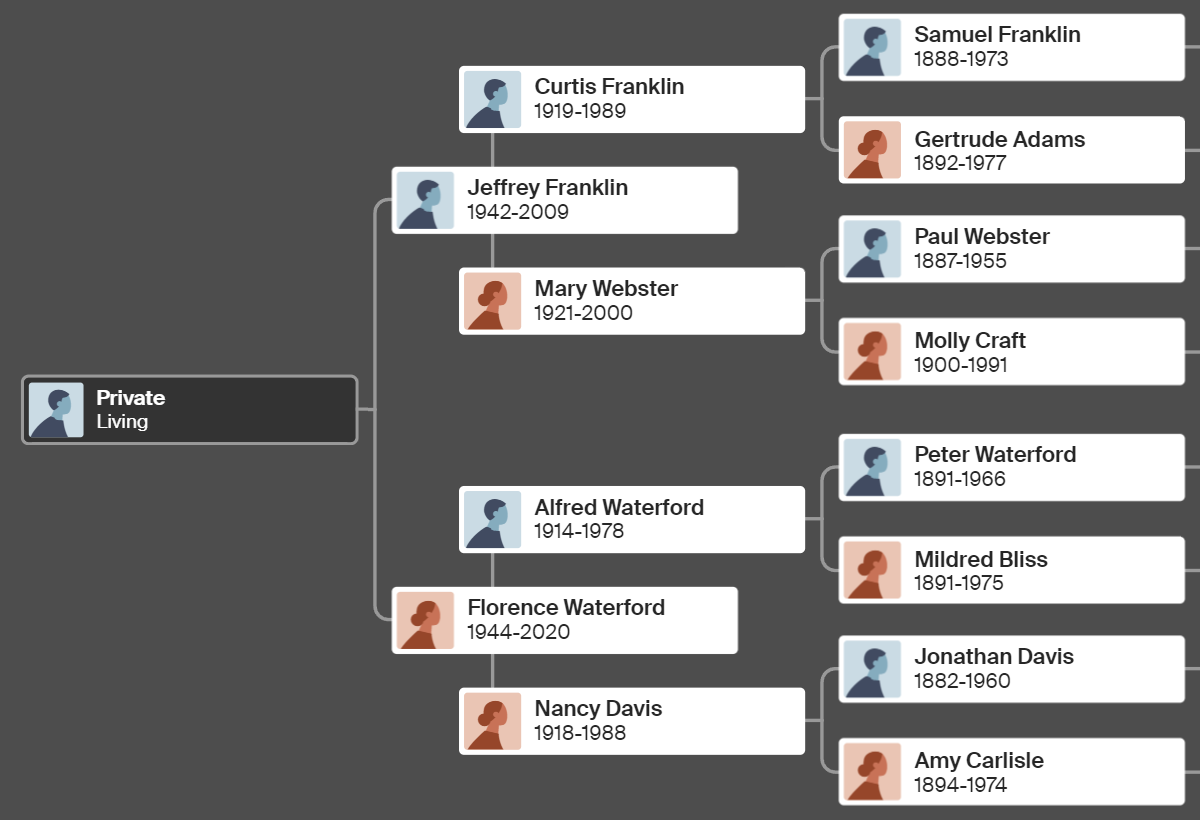
First, notice that William is not a DNA match to the two Smith matches (Joe and Michael). That's good. It's very possible William is on your grandfather's side of the family. Notice we don't see George Franklin in his tree though. Franklin is the name we’re looking for, so let’s see if we can somehow connect the George Franklin who married Jane Smith to the people in William’s tree. Looking at William’s tree, we see that his parents were born in the 1940s. He’s likely a similar age to you. William’s DNA match to you is 203cM. His tree shows Samuel Franklin married to Gertrude Adams, both born in the late 1800s. It shows their son Curtis Franklin born 1919. If you were to make an assumption about William’s relationship to you, what would it be? Where would George Franklin fit into all of this?
-
ANSWER
Maybe William is in the same generation as you and is a second cousin. It would mean you have two great-grandparents in common, (Samuel and Gertrude). It would also mean, William’s grandparent, Curtis Franklin, is a sibling of your grandparent. The names, centimorgan number and ages all make sense. Do you get it? After doing research, we discover George Franklin is a sibling of Curtis Franklin and a child of Samuel and Gertrude. William is your second cousin. George Franklin is your grandfather.
We now know what family Parent 1 comes from. It should be easy to find your birth parent now, right? Let’s throw a wrench into this puzzle and make it a little more difficult. If your grandparents (Jane and George) only had one child this would be easy, right? That child would your birth parent. Let’s make this a pretty big family and say they had six children: Stanley, Patricia, Molly, Helen, Caroline and Joshua. Any of them can be your birth parent. If you had DNA matches to any of them they could be confirmed or eliminated. If they had children or grandchildren who did DNA, they could help as well. Can you explain why DNA can eliminate or confirm them as your birth parent? What would your relationship be to the six siblings? What would their children's relationship be to you?
-
ANSWER
If your birth parent did DNA, they would likely show up with a match of about 3500cM. If an aunt or uncle (your birth parent's sibling) did DNA, they would have a match of about half that. I often see numbers ranging from 1400-2000 for aunts and uncles. If an aunt or uncle’s child did DNA, they would be your first cousin and matching about 800-1000cM on average. If your first cousin had a child who did DNA, they would be a first cousin once removed. They would match like Joe, probably in the 400-500cM range on average. NOTE: There’s two ways to think about removed cousins. For example, Joe is a cousin of your parent. He is an older generation first cousin one removed. A child of YOUR cousin would be a younger generation first cousin once removed. Both relationships are the same and have centimorgan numbers in the same range. So, if people are matching you as first cousins or first cousins once removed, it eliminates their parent or grandparent as your parent. (You obviously can't have the same parent as your first cousins).
Well, at this point we know one of your birth parents is a child of Jane and George, if all our assumptions have been correct. You have no aunt/uncle matches, and no first cousin matches either. Is this the end of the road? Sometimes it is. DNA matches and centimorgan numbers can sometimes only get you to the correct family, not the exact person. WAIT! What about our mystery match, Lindsay Littlebrook? Did you notice, when we did a shared match with Joe, she showed up on the list. When we did a shared match with William, she also showed up on the list. This means, she’s related to BOTH Smith AND Franklin families. Take a moment and think about that. How is it possible for Lindsay to be related to both families? She seems to be related to BOTH of your grandparents. The shared matches and her centimorgan number is all the info we have. Make an assumption. What is your most likely relationship to Lindsay?
-
ANSWER
We just discussed it moments ago. Chances are she’s a younger generation first cousin once removed. That would be my assumption. The centimorgan number would back that up also. It would mean your grandparents are her great-grandparents. Therefore, she’s related to both Smith and Franklin. It also means, her parent is your first cousin, and her grandparent is a sibling of one of your six possible birth parents. If you could find out who her grandparent is, it would eliminate one of the six. Now it gets interesting. Keep reading...
What often happens in these searches is, things get crazy and things end up not being what you expect. I’ll give you an example of that here. Let’s pretend we did a search for information on Lindsay Littlebrook. Her name isn’t appearing on Ancestry though. People-search-sites have no info either. It’s like she doesn’t exist. That’s strange. Usually you can find something out there. One reason for lack of info is, children are often not included in people searches for their protection. Could she be really young?
After doing an extensive search, we find a high school soccer team schedule from a school in Chicago. On the team is a 15 year old girl named Lindsay Littlebrook. Not a common name. Could this be our girl? Could she really be almost fifty years younger than you? This changes things. It’s time to reevaluate the relationship and make a new assumption. This is your final test. If this is the correct Lindsay, how is she most likely related? I'll give you a hint, she's not a first cousin once removed. Think about possible relationships. Think about centimorgans. Try to get this before going further.
-
ANSWER
Because Lindsay is so young, it is now possible she is TWO generations younger than you. Your first thought might be, first cousin twice removed (a grandchild of your cousin). If you read my previous blog posts and learned about centimorgans, then you know that's pretty much impossible. She has way too much DNA in common. The most likely relationship to Linsday is... She is your HALF GRAND NIECE. Therefore, she would be a grandchild of your half sibling. In other words, you and one of her grandparents have the same parent. If all of this is correct, you're on your way to finding a birth parent AND a half sibling.
-
MORE INFORMATION
Now we'll pretend we did some research to find out about Lindsay's family. We discover one of your possible birth parents, Patricia Franklin, married a man named Charles Littlebrook in 1963. They only had only one child, a son named Stephen Littlebrook born in 1964 in Chicago. Because of the unusual last name, this would be enough to convince me that everything is correct and I would start contacting everyone possible from that family to confirm it. Most of my searches get to this point eventually. You just have to find someone who knows the family and can get you in touch with the right people.
-
FINAL RESULT
Patricia (Franklin) Littlebrook is your mother. After getting in contact with the family, we confirmed that Lindsay's great-grandmother was Patricia. Patricia's son, Stephen, is your half brother. Patricia's husband is NOT your father though. That would make Lindsay your full grand niece and she would likely match around 800cM. Patricia had a child (you) before marrying Mr. Littlebrook. So, the names, dates, location and DNA levels all worked out perfectly in this case. If no one in Patricia's family can tell you who your father is, your next step would be to start looking at the parent 2 side of your match list. Even if someone does tell you, you'd still want to look at the list and use the same process to confirm the father.
Final Thoughts and Tips
Location, Location, Location - Don't forget about location. That's something always worth looking into. If you know where you were born, see if you can place the possible birth parents at that location at the right time. In this case, everyone was from Chicago, so there were no location issues. It's even possible to solve a mystery only using location. For example, I once worked with someone born in up-state New York. When looking at her match list and trees, everyone on the father's side was from Georgia. It made no sense. Rather than analyse some confusing matches, I looked at people in the trees and looked for a New York connection. I quickly found only one guy who moved there, and he moved to the exact same town. He was in the military, stationed in up-state New York at the right time. We made contact and confirmed he was the right guy.
Go Deeper Into the Trees - In many cases, like this one, when you suspect the right person, you can contact the family and confirm it without further research. Let's imagine, we were not able to make contact with anyone. I would want to take this case a little further just to be sure. To test your knowledge of centimorgan numbers, it's time for a bonus question. There's three additional matches on the full parent 1 list. Jean Biggs (137cM), Mary Duffy (75cM), and Lori Parker (49cM). If these people have good trees made, I would use them to confirm the relationships of the big matches even further. Before I explain that, here's the bonus question... Jean, Mary, and Lori are all in your generation. They all have the exact same relationship to you. Based on that info alone, what would be a good assumption of what their relationship is to you?
-
BONUS ANSWER
My assumption would be, third cousins. Remember, I said they are all in the same generation as you, so there's no removed cousins here. When you get to third cousin level, you can see big swings in the DNA numbers. An average third cousin is about 75cM, but all three of these matches are well within range. One is a little below average, one is a little above. I would take the time to look at their trees and find out where they fit into your family. Their common ancestors will be a generation further back. For example, Lori is a DNA match to Joe. She's going to be either a Smith OR Jones match, not both. These third cousins will have two great-great grandparents in common with you. When distant matches have clear connections to the closer matches, it can really confirm the relationships.
This is just a glimps at what the power of DNA matching and logic can do. It can get a whole lot harder than this. Just to give you an example, I was working with someone who was trying to identify who their great-grandparent was. I discovered many people on the match list all related to the same guy. His name was Earl. Everything was pointing to him as the guy I was looking for. To make a long story short, in the end, I ended up discovering a whole lot of people had wrong information in their trees. None of them were related to Earl at all. This is a possibility you sometimes have to deal with. There's a lot of inaccurate trees out there. DNA is revealing that generations of people have no idea what family they really belong to. I've written an article about this subject. Below is a list of posts that are related to this one. I hope you got something out of this lengthy post and now have some understanding of everything that goes into a search. Let me know if you have any questions.
Related Posts
Centimorgan CalculatorFamily Relationships - Part 1
Family Relationships - Part 2
DNA Numbers Lesson
What Generation Am I In?
The False Family Line
Next, find out how DNA and research revealed someone's secret identity.

